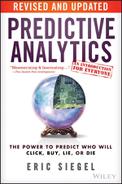Appendix B
Twenty Applications of Predictive Analytics
These applications—ways in which predictive analytics is employed—are covered within the chapters noted. Others beyond these 20 are listed in this book's Central Tables.
- What's predicted: Which customers will respond to marketing contact.
- What's done about it: Contact customers more likely to respond.
- What's predicted: Which ad each customer is most likely to click.
- What's done about it: Display the best ad (based on the likelihood of a click as well as the bounty paid by its sponsor).
- What's predicted: Whether a stock will go up or down.
- What's done about it: Buy stocks that will go up, and sell those that will go down.
- What's predicted: Which female customers will have a baby in coming months.
- What's done about it: Market relevant offers for soon-to-be parents of newborns.
- What's predicted: Which employees will quit.
- What's done about it: Managers take the predictions for those they supervise into consideration, at their discretion. This is an example of decision support rather than feeding predictions into an automatic decision process.
- What's predicted: The location of a future crime.
- What's done about it: Police patrol the area.
- What's predicted: Which transactions or applications for credit, benefits, reimbursements, refunds, and so on are fraudulent.
- What's done about it: Human auditors screen the transactions and applications predicted most likely to be fraudulent.
- What's predicted: Which low-level Internet communications originate from imposters.
- What's done about it: Block such interactions.
- What's predicted: Which e-mail is spam.
- What's done about it: Divert suspected e-mails to your spam e-mail folder.
- What's predicted: Which game board state will lead to a win.
- What's done about it: Make a game move that will lead to a state predicted to lead to a win.
- What's predicted: Whether a prosecuted criminal will offend again.
- What's done about it: Judges and parole boards consult model predictions when making decisions about an individual's incarceration.
- What's predicted: Whether an individual is a “person of interest.”
- What's done about it: Individuals with a sufficiently high predictive score are considered or investigated.
- What's predicted: Which customers will leave.
- What's done about it: Retention efforts target at-risk customers.
- What's predicted: Which mortgage holders will prepay within the next 90 days.
- What's done about it: Mortgages are valued accordingly in order to decide whether to sell them to other banks.
- What's predicted: What rating a customer would give to a movie.
- What's done about it: Customers are recommended movies that they are predicted to rate highly.
- What's predicted: Given a question and one candidate answer, whether the answer is correct.
- What's done about it: The candidate answer with the highest predictive score is provided by the system as its final answer.
- What's predicted: Which questions a student will get right or wrong.
- What's done about it: Spend more study time on the questions the student will get wrong.
- What's predicted: Which customers will be persuaded to buy.
- What's done about it: Target persuadable customers.
- What's predicted: Which customers can be persuaded to stay.
- What's done about it: Retention efforts target persuadable customers.
- What's predicted: Which voter will be positively persuaded by political campaign contact such as a call, door knock, flier, or TV ad.
- What's done about it: Persuadable voters are contacted, and voters predicted to be adversely influenced by contact are avoided.
..................Content has been hidden....................
You can't read the all page of ebook, please click here login for view all page.
